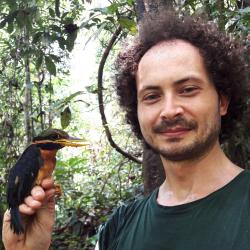The Anthropocene is an era characterized by global environmental changes due to human activities. In response to habitat change, such as logging, animal species can be forced to shift their range or physiologically cope with the new environmental conditions. While some species thrive, others decline following these changes. Understanding proximate mechanisms of variation in local abundance of animal populations may help conservationists developing new tools for monitoring the efficacy of management strategies, and predicting the long-term viability of animal populations.
I carried out projects in the Danum Valley Conservation Area, in Malaysian Borneo, investigating the impacts of forest selective logging on the stress physiology and genomic diversity of tropical understorey birds. By applying biochemical and molecular tools, my coauthors and I assessed questions on the (i) link between markers of stress physiology and population abundance change; (ii) prevalence of blood parasites infection; (iii) and genomic diversity between populations of birds inhabiting primary and selectively logged forests.
Currently, I am a postdoctoral researcher at the University of Tuscia, in Viterbo (Italy). I am involved in projects assessing eco-physiological questions on birds, mammals and amphibians following land-use changes, climate changes, and the introduction of invasive species. I established international collaborations with the University of Cambridge (UK), National University of Singapore, University of Veterinary Medicine (Vienna, Austria), Leibniz Institute for Zoo and Wildlife Research (Berlin, Germany), and the University of Antwerp (Belgium).

